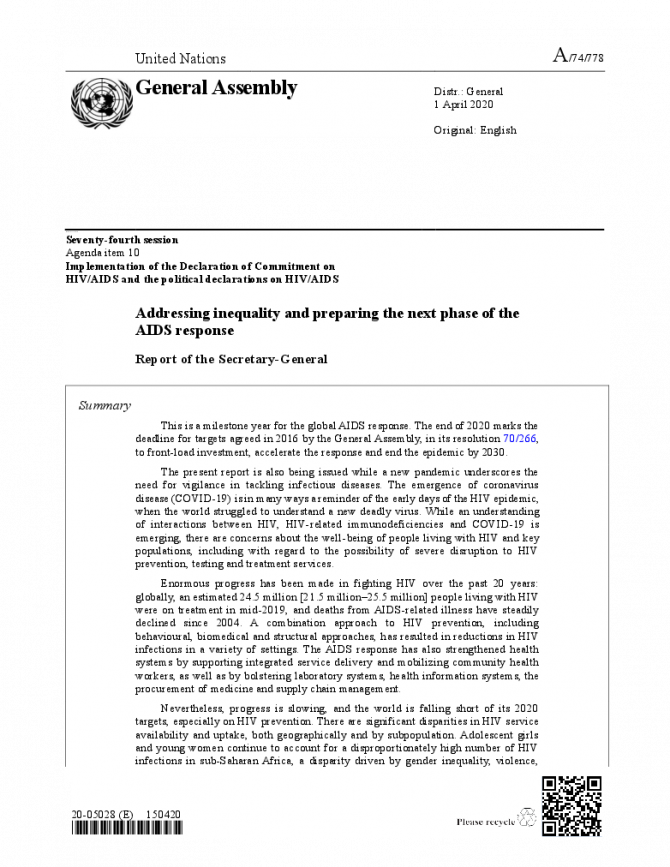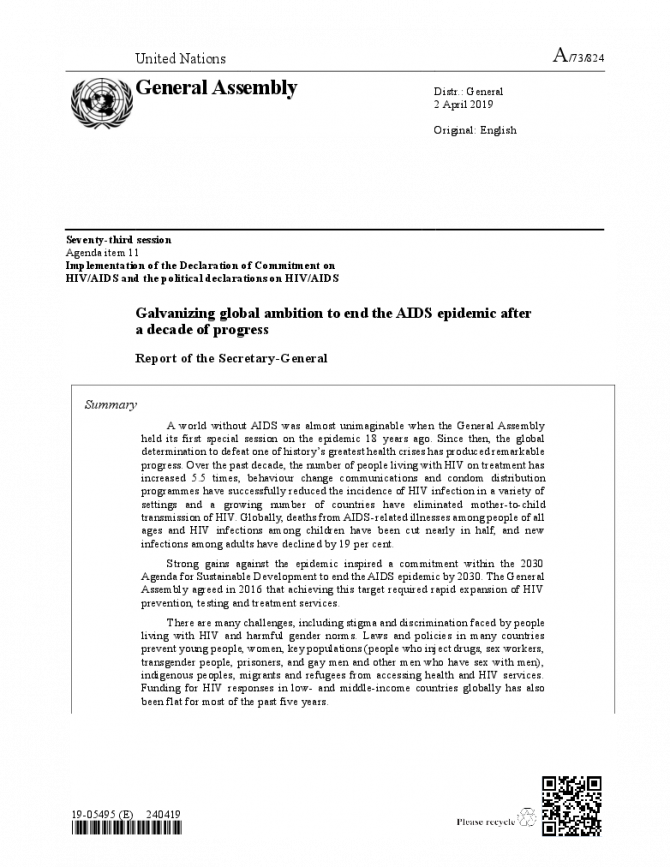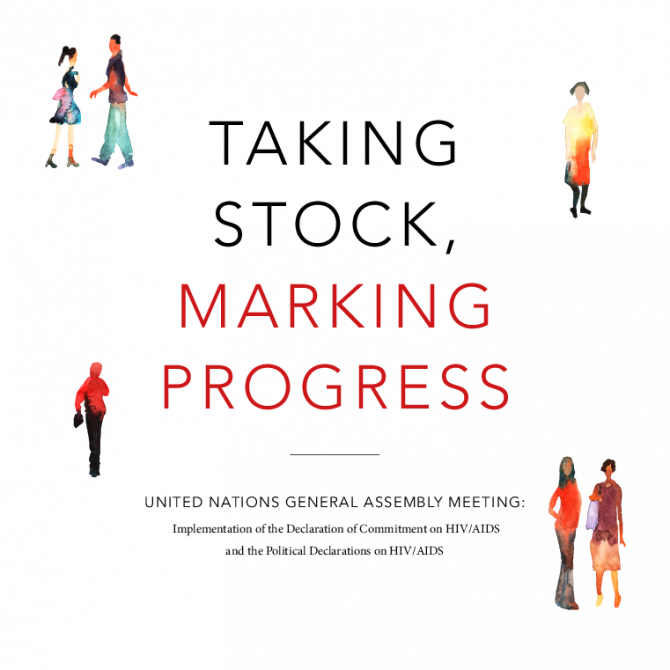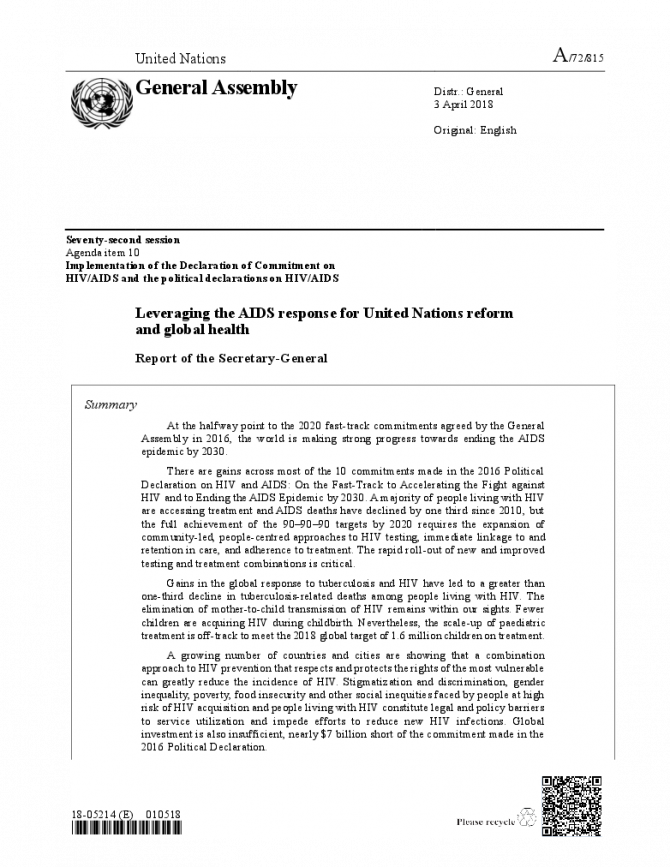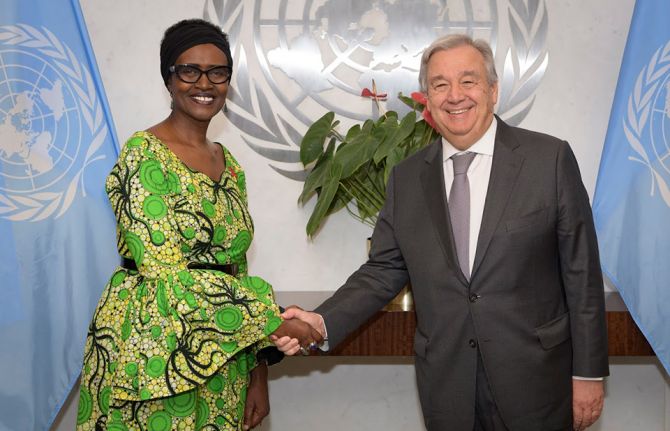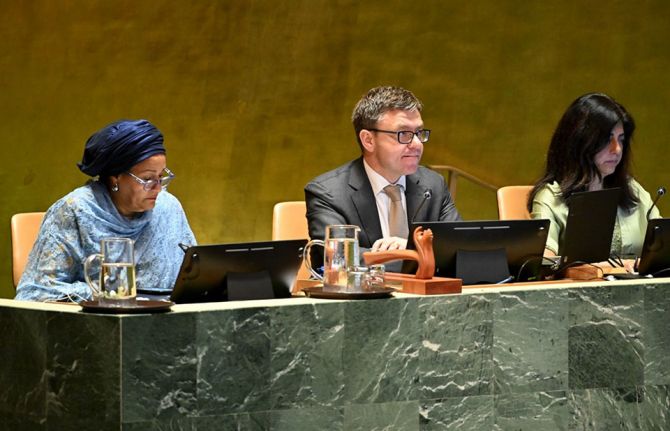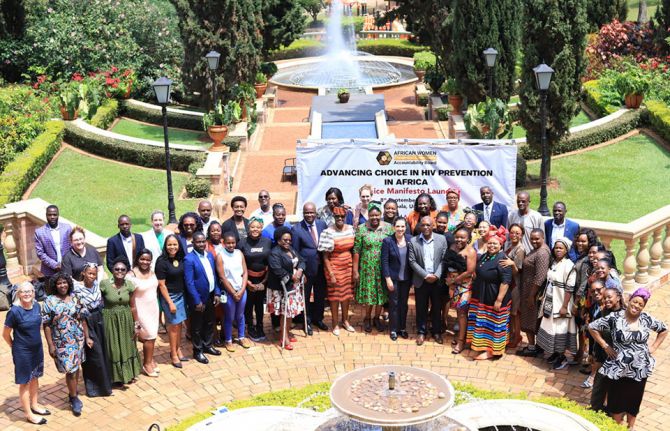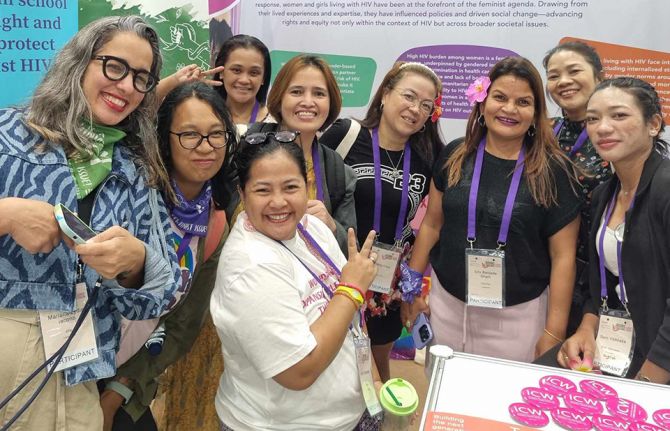Documents
Report of the UN Secretary-General on the Implementation of the Declaration of Commitment on HIV/AIDS and the political declarations on HIV/AIDS (Seventy-fourth session of the General Assembly) 1 April 2020 - A/74/778
01 April 2020
This is a milestone year for the global AIDS response. The end of 2020 marks the deadline for targets agreed in 2016 by the General Assembly, in its resolution 70/266, to front-load investment, accelerate the response and end the epidemic by 2030.

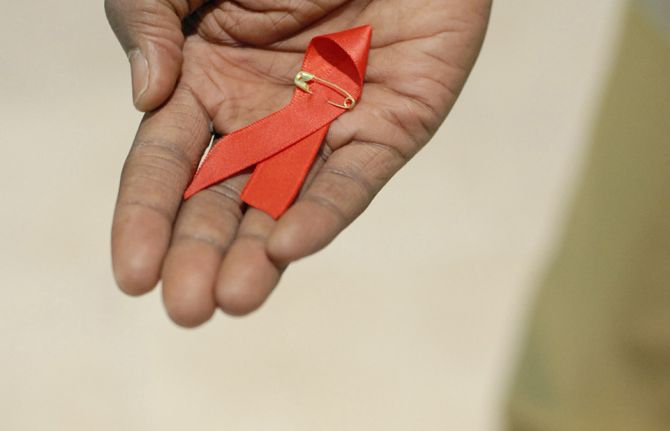
Press Release
Galvanizing global ambition to end the AIDS epidemic after a decade of progress
03 June 2019 03 June 2019NEW YORK/GENEVA, 3 June 2019—A new report from the United Nations Secretary-General, Galvanizing global ambition to end the AIDS epidemic after a decade of progress, has been presented to United Nations Member States during the 73rd session of the United Nations General Assembly. The Member States gathered at the United Nations in New York, United States of America, to review progress and share their own progress and challenges.
“A world without AIDS was almost unimaginable when the General Assembly held its first special session on the epidemic 18 years ago,” said United Nations Secretary-General António Guterres in the report. “Since then, the global determination to defeat one of history’s greatest health crises has produced remarkable progress … and … inspired a commitment within the 2030 Agenda for Sustainable Development to end the AIDS epidemic by 2030.”
The Secretary-General’s report shows that results once derided as impossible in low-income settings have now been achieved following a decade of progress in the response to HIV. Between 2008 and 2017, there was a 43% reduction in AIDS-related deaths, a 45% reduction in new HIV infections among children and a 19% reduction in new HIV infections among adults globally. The number of people living with HIV on treatment also increased, by 5.5 times, reaching 21.7 million of the 36.9 million people living with HIV in 2017.
“The enormous achievements in the response to HIV in recent decades, under the strong leadership of UNAIDS, is one of the best examples of multilateralism in action,” said María Fernanda Espinosa, President of the United Nations General Assembly. “It is most definitely an indication of what we can achieve when we work together around a common cause."
The report shows that progress has been most marked in eastern and southern Africa, where AIDS-related deaths fell by 53% and new HIV infections among adults and children fell by 36%. An epidemic that once killed more than a million people in the region per year now claims fewer than 400 000 lives per year.
In other regions of the world, including Latin America, the Caribbean, Asia and the Pacific, western and central Europe and North America, increases in the coverage of HIV testing and treatment services have achieved significant reductions in AIDS-related deaths over the past decade. Most of those regions have also experienced declines in new HIV infections.
Notable exceptions are eastern Europe and central Asia, where the annual number of new HIV infections has risen by 30% since 2010, with an estimated 960 000 people newly infected over this time, and in the Middle East and North Africa, where deaths from AIDS-related illnesses increased by 11%, an estimated 140 000 people newly infected, over the same period.
The report notes that services focused on key populations within those regions are few and far between, and harsh punishments for same-sex sexual relationships, drug use and sex work in those regions and elsewhere are proving to be formidable barriers to the few services that are available.
In western and central Africa, insufficient domestic funding, weak health systems, formal and informal user fees for health care, humanitarian situations and high levels of stigma and discrimination continue to undermine efforts to scale up HIV testing and treatment.
Many challenges remain, including stigma and discrimination faced by people living with HIV and harmful gender norms. Laws and policies in many countries prevent young people, women, key populations―gay men and other men who have sex with men, sex workers, transgender people, people who inject drugs and prisoners and other incarcerated people―indigenous people, migrants and refugees from accessing health and HIV services.
Funding for HIV responses in low- and middle-income countries globally has also remained flat for most of the past five years. In 2017, donor and domestic investments in low- and middle-income countries were US$ 20.6 billion, about 80% of the 2020 target.
“As the Secretary-General’s report makes abundantly clear, to protect the gains we have made and to tackle the challenges that stand in the way of our promise to end AIDS by 2030, we need to firm up our resolve, strengthen our partnerships and say no to complacency,” said Gunilla Carlsson, UNAIDS Executive Director, a.i. “Let’s start with a successful replenishment that results in a fully funded Global Fund to Fight AIDS, Tuberculosis and Malaria that will enable it, along with its range of partners, including UNAIDS, to continue to deliver evidence-informed, people-centred and human-rights based support to the people and communities who need it the most.”
The report outlines that there is an important opportunity to seize the growing momentum to achieve universal health coverage, a core principle of which is leaving no one behind. Collaboration between health systems and community groups has been shown to reduce stigma and discrimination and to help to deliver services to the people in greatest need―a key recommendation of the report is the strengthening of the vital role that community groups play in the AIDS response.
In the report, the United Nations Secretary-General urges Member States to adopt the following recommendations to galvanize political will, accelerate action and build the momentum necessary to reach the 2020 targets agreed to by the United Nations General Assembly in the 2016 United Nations Political Declaration on Ending AIDS: (a) reinvigorate primary HIV prevention; (b) diversify HIV testing and differentiate the delivery of health care to reach the 90–90–90 targets; (c) establish enabling legal and policy environments in order to reach marginalized and vulnerable populations; (d) mobilize additional resources and allocate them where they are most needed; (e) support communities to enable them to play their critical roles; and (f) incorporate a comprehensive HIV response into universal health coverage.
UNAIDS
The Joint United Nations Programme on HIV/AIDS (UNAIDS) leads and inspires the world to achieve its shared vision of zero new HIV infections, zero discrimination and zero AIDS-related deaths. UNAIDS unites the efforts of 11 UN organizations—UNHCR, UNICEF, WFP, UNDP, UNFPA, UNODC, UN Women, ILO, UNESCO, WHO and the World Bank—and works closely with global and national partners towards ending the AIDS epidemic by 2030 as part of the Sustainable Development Goals. Learn more at unaids.org and connect with us on Facebook, Twitter, Instagram and YouTube.
Contact
UNAIDS GenevaSophie Barton-Knott
tel. +41 22 791 1697
bartonknotts@unaids.org
UNAIDS Media
tel. +41 22 791 4237
communications@unaids.org
Press centre
Download the printable version (PDF)
Documents
Report of the UN Secretary-General on the Implementation of the Declaration of Commitment on HIV/AIDS and the political declarations on HIV/AIDS (Seventy-third session of the General Assembly) 2 April 2019 - A/73/824
02 April 2019


Press Statement
United Nations Member States stress that critical efforts must be scaled up to end AIDS
13 June 2018 13 June 2018United Nations Secretary-General presents his report on HIV as United Nations General Assembly meets to review progress towards ending AIDS
NEW YORK/GENEVA, 13 June 2018—At the halfway point to the 2020 Fast-Track Targets agreed by the United Nations General Assembly in 2016, United Nations Member States have come together to review progress in responding to HIV. Gathered at the United Nations Headquarters in New York, United States of America, Member States presented the progress and challenges in their countries and heard from the United Nations Secretary-General, who presented his report on the global response to HIV.
The President of the General Assembly Miroslav Lajčák opened the meeting. “We cannot forget that what we are doing today ties into our other goals and objectives,” he said. “We can use today’s meeting to explore opportunities for even more action. Let’s keep going. Let’s keep fighting this virus—and the stigma that comes with it.”
The United Nations Secretary-General presented his report, Leveraging the AIDS response for United Nations reform and global health, and said, “The world is making good progress towards ending the AIDS epidemic by 2030, but progress is uneven and fragile. At this pivotal moment, we must renew our focus and shared commitment to a world free of AIDS.”
The report shows that the exponential scale-up of antiretroviral therapy has now reached more than half of all people living with HIV, which in turn has contributed to a decline of one third in AIDS-related deaths, from 1.5 million in 2010 to 1 million in 2016. It also notes the progress in stopping new HIV infections among children and highlights that eliminating mother-to-child transmission of HIV is possible if the world remains focused.
The Executive Director of UNAIDS, Michel Sidibé, attended the plenary meeting. He said, “We are at a critical juncture on the path towards ending AIDS. We must unite and use our collective force to push HIV into permanent decline.”
More than 30 Member States reported on progress in their countries, many expressing their appreciation and support for the work of UNAIDS and the Joint Programme while reiterating their commitment to achieving the targets in the 2016 United Nations Political Declaration on Ending AIDS.
“The United States strongly supports UNAIDS and its leadership in combatting the HIV/AIDS pandemic,” said Deborah Birx, United States Global AIDS Coordinator and Special Representative for Global Health Diplomacy. “UNAIDS’ focus on producing the most extensive data collection on HIV epidemiology continues to be fundamentally important and is our road map to controlling this pandemic. We cannot achieve the targets to end the AIDS epidemic by 2030 without the right data to track our progress, pinpoint our unmet need and effectively and efficiently direct resources for maximum impact.”
The report of the United Nations Secretary-General shows that while the number of people accessing treatment almost tripled from 2010 to June 2017, from 7.7 million people on treatment to 20.9 million, 15.8 million people are still in need of treatment, and progress in expanding access to treatment for children is particularly slow. Just 43% of children living with HIV had access to treatment in 2016.
It also flags that more needs to be done to stop new HIV infections. New HIV infections declined by 18% from 2010 to 2016, from 2.2 million to 1.8 million, but to reach the target of 500 000 new infections by 2020 HIV prevention efforts must be significantly stepped up, particularly among populations at higher risk, a sentiment echoed by many of the speakers at the plenary meeting.
Lazarus O. Amayo, Permanent Representative of Kenya to the United Nations, spoke on behalf of the African Group. “A lot remains to be done as AIDS continues to disproportionately affect sub-Saharan Africa, with the risk of new HIV infections remaining exceptionally high among young women in eastern and southern Africa,” he said. “We reiterate the need for a comprehensive, universal and integrated approach to HIV and AIDS, as well as investments towards it.” In eastern and southern Africa, young women aged between 15 and 24 years account for 26% of new HIV infections, despite making up just 10% of the population.
The report shows there is still much work to do to reach the targets in the 2016 United Nations Political Declaration on Ending AIDS, including filling the US$ 7 billion shortfall in funding for the AIDS response. It sets out five strong recommendations to get countries on track, including mobilizing an HIV testing revolution, safeguarding human rights and promoting gender equality and using the HIV Prevention 2020 Road Map to accelerate reductions in new HIV infections.
In 2016 (*June 2017) an estimated:
- *20.9 million [18.4 million–21.7 million] people were accessing antiretroviral therapy (in June 2017)
- 36.7 million [30.8 million–42.9 million] people globally were living with HIV
- 1.8 million [1.6 million–2.1 million] people became newly infected with HIV
- 1.0 million [830 000–1.2 million] people died from AIDS-related illnesses
UNAIDS
The Joint United Nations Programme on HIV/AIDS (UNAIDS) leads and inspires the world to achieve its shared vision of zero new HIV infections, zero discrimination and zero AIDS-related deaths. UNAIDS unites the efforts of 11 UN organizations—UNHCR, UNICEF, WFP, UNDP, UNFPA, UNODC, UN Women, ILO, UNESCO, WHO and the World Bank—and works closely with global and national partners towards ending the AIDS epidemic by 2030 as part of the Sustainable Development Goals. Learn more at unaids.org and connect with us on Facebook, Twitter, Instagram and YouTube.
Documents
Taking stock, marking progress - United Nations General Assembly meeting: Implementation of the Declaration of Commitment on HIV/AIDS and the Political Declarations on HIV/AIDS
29 June 2018
This brochure highlights some of the key remarks made by Member States at this year’s gathering on the state of the worldwide response to HIV. While much progress has been made, there is a clear agreement that we still have a long way to go. The disproportionate effect of the HIV epidemic on young women and adolescent girls, and the slow uptake of HIV services by men and boys, are but a few of the challenges that need to be addressed.
Documents
Report of the UN Secretary-General on the Implementation of the Declaration of Commitment on HIV/AIDS and the political declarations on HIV/AIDS (72nd session of the General Assembly)
03 April 2018

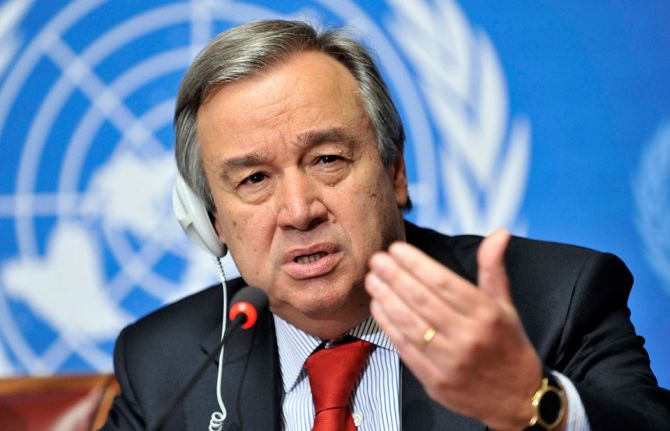
Update
Report of the United Nations Secretary-General
01 June 2017
01 June 2017 01 June 2017The report of the United Nations Secretary-General: Reinvigorating the AIDS response to catalyse sustainable development and United Nations reform will be presented to the United Nations General Assembly in New York, United States of America on 1 June at 10 a.m. New York time (3 p.m. GMT).
The report was presented by the Deputy Secretary-General of the United Nations, Amina Mohammed, on behalf of the United Nations Secretary-General, and serves to inform discussions around progress and challenges in achieving the bold targets and milestones set out in the United Nations Political Declaration on Ending AIDS, adopted by the United Nations General Assembly at its high-level meeting in June 2016.
The proceedings were opened by the President of the United Nations General Assembly, Peter Thomson, and were followed by statements from representatives of United Nations Member States.
Quotes
“In developing the Sustainable Development Goals, it was clear how relevant and innovative the approach to ending AIDS had been and how important it would continue to be. Achieving our aim on AIDS is interlinked and embedded within the broader 2030 Agenda for Sustainable Development. Both are grounded in equity, human rights and a promise to leave no one behind.”
“We have before us a critical window of opportunity to end the AIDS epidemic. But to do so we must take action now. Let us therefore seize the opportunity of today’s review to commit to accelerating our efforts to implement the Political Declaration on Ending AIDS, to achieving the 2030 Agenda for Sustainable Development and to creating a future where HIV and AIDS are consigned to the sorrows of the past.”
Related
Documents
Reinvigorating the AIDS response to catalyse sustainable development and United Nations reform
01 June 2017
During my first months as Secretary-General, I have called on the international system to get back to basics: to put greater focus on building more resilient societies by putting respect for human rights at the centre of national and international policy, by reducing disenfranchisement and marginalization and by empowering women and girls. I have also called on the United Nations development system to increase the pace of reform — to become more nimble, efficient and effective. The AIDS response is a bellwether for both agendas: sustainable development and United Nations reform.

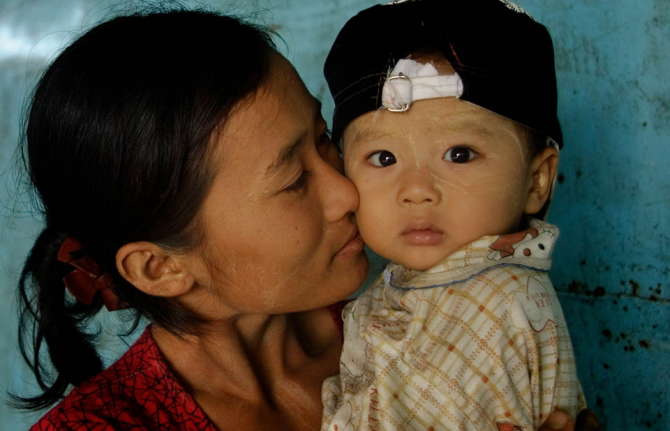
Update
Every woman and every child healthy and empowered
24 April 2017
24 April 2017 24 April 2017The health and well-being of women, children and adolescents are central to building peaceful, sustainable and inclusive societies. This is why in 2010 the then United Nations Secretary-General, Ban Ki-moon, launched Every Woman Every Child, a global movement to mobilize and intensify action by governments, multilateral organizations, the private sector and civil society to address the major health challenges facing women, children and adolescents around the world.
Showing his support for these efforts, on 21 April United Nations Secretary-General António Guterres became the third and senior Co-Chair of Every Woman Every Child, alongside the President of Chile, Michelle Bachelet, and the Prime Minister of Ethiopia, Hailemariam Desalegn. The announcement was made at a meeting of the Every Woman Every Child steering group, held on the margins of the spring meetings of the World Bank Group and the International Monetary Fund.
Every Woman Every Child unites its partners to deliver on an integrated agenda for women’s, children’s and adolescents’ health and well-being. It also puts into action a Global Strategy for Women’s, Children’s and Adolescents’ Health, a road map to ending all preventable deaths of women, children and adolescents within a generation and ensuring their well-being.
The core partners of Every Woman Every Child include the H6 (UNAIDS, the United Nations Population Fund, the United Nations Children’s Fund, UN Women, the World Health Organization and the World Bank Group), the Partnership for Maternal, Newborn and Child Health, the Global Financing Facility in support of Every Woman Every Child and the Every Woman Every Child Innovation Marketplace.
Over the past seven years, the movement has galvanized ambitious action and coordinated efforts across sectors. Since 2015, more than 60 country commitments and 150 multistakeholder commitments totalling more than US$ 27 billion have been made by the partners of Every Woman Every Child to deliver on the promises of a sustainable future for all by 2030.
Quotes
“Peace cannot exist without development and development cannot exist without health and well-being, for healthy and empowered women, children and adolescents can bring about the change needed to create a better future for all.”
“We have a unique opportunity to address the health challenges facing women, children and adolescents. I am committed to Every Woman Every Child and will continue to work to help ensure a better future for all.”
“We have made progress, but it has been uneven. We need to accelerate our efforts and actions to help women, children and adolescents to survive, thrive and transform.”

